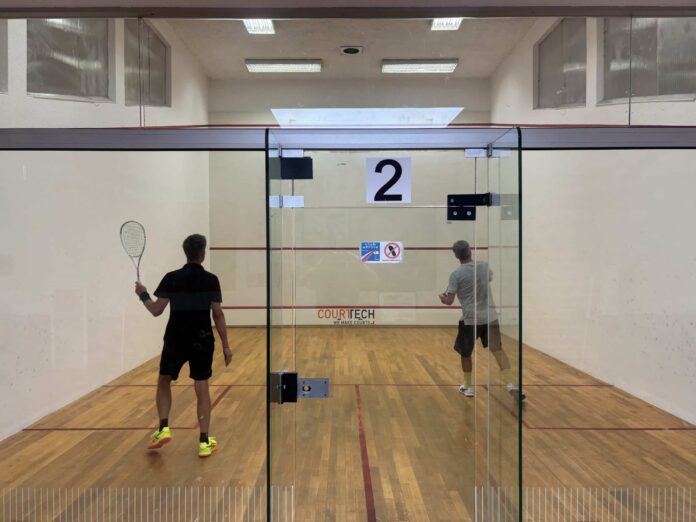In Nice, squash doesn’t have the visibility of tennis or padel, but it has its venues and loyal followers. Between specialized clubs and courts integrated into complexes, the little black ball keeps bouncing in the city of Nice.
It is 11 o’clock at the Vauban club, and squash is already hitting hard. As soon as you step through the club’s door, a rhythm imposes itself: tac-tac-tac, the sharp sound of the black ball on the walls. In less than ten minutes, t-shirts are soaked. “Here, you don’t need coffee to wake up,” smiles a regular with a towel around his neck. The image is clear: squash is a sport that tires you out, but it’s also addictive.
The rules are simple: hit the ball against the front wall and prevent the opponent from retrieving it after two bounces. The French Squash Federation estimates that an hour of play burns between 700 and 1000 calories, much more than a regular tennis match. The ball, smaller and heavier, can reach 250 km/h at high levels. The result: a short, explosive pace without downtime.
Lucas, 35, confirms as he exits the court: “I’ve played tennis all my life, but squash is another world. In twenty minutes, I’m exhausted. Yet I keep coming back.”
A Small Community
In France, squash remains discreet: about 18,000 registered players versus nearly 900,000 in tennis. In the Alpes-Maritimes, the map is quickly filled: only four clubs, two in Antibes, one in Monaco, and the one in Nice, here in Vauban. There are also two courts in Saint-Augustin, integrated into a multi-sport complex, but the offering there is more limited.
This rarity does not prevent loyalty. “We all end up knowing each other,” says Thibault, a squash regular for over ten years. “You come in, you see the same faces, you play with people of all levels. It’s a small family.” This friendliness is part of the charm: after an intense match, people gather around a coffee or discuss upcoming tournaments.
Stéphane and Philippe are proof of this. “I play twice a week,” explains Philippe. “But there are those who play even more. What struck me is seeing guys aged 60 or 70 running like youngsters. It’s impressive.”
Beside him, Stéphane smiles, recalling his beginnings: “A friend once told me: come try, you’ll see. I had never held a tennis racket. I don’t know how to play tennis at all. But I tried squash and never stopped.”
Squash in Daily Life
At Vauban, playing costs 12 euros per hour for a court. The most represented age group is between 25 and 50 years, with most players booking after 6 PM, once their workday is over. Mornings remain the time for retirees and freelancers, who enjoy the quiet and the availability of the courts.
For Stéphane, this diversity is a strength: “You can come across a 14-year-old kid in a tournament or a 60-year-old veteran. And both will make you run just the same.” Philippe adds: “It’s a fascinating sport, really. Once you start, you play, you replay, and you end up organizing your week around it.”
Why It Persists
Against padel, which attracts with its accessibility and trendy aspect, squash maintains its specificities: intensity, time efficiency, energy expenditure. “In forty minutes, you’ve completed your weekly workout,” sums up Stéphane. “You don’t need an entire afternoon, everything is concentrated in a box.”
“Padel is nice, but it’s closer to tennis. Here, the ball doesn’t bounce. If you don’t hit it, it dies on the floor. And since there’s no pause, you can’t stop. That’s what’s great,” concludes Philippe.
The equipment remains minimalist: a racket, a black ball, indoor shoes. But behind this simplicity lies real strategic richness. “It’s super tactical,” insists Stéphane. “You can win a point without hitting hard, just by varying, by feinting.”
Between Legacy and Future
In Nice, squash reached its peak in the 1990s, when several private complexes offered courts. Many have since closed, but the enthusiasts remain. Regional competitions continue to be held, bringing together several dozen players from the department.
The sport remembers its great French champions: Thierry Lincou, crowned world champion in 2004, and Grégory Gaultier, in 2015.
Furthermore, squash will make its debut at the Los Angeles Olympics in 2028. A long-awaited recognition spanning decades. “With this, the sport can revive,” hopes Stéphane. “If kids see squash on TV, it might inspire a new generation.”


